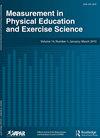握力、垂直跳跃力和平板支撑时间对小儿肌肉萎缩症的预测有效性
IF 1.9
4区 教育学
Q2 EDUCATION & EDUCATIONAL RESEARCH
Measurement in Physical Education and Exercise Science
Pub Date : 2021-10-19
DOI:10.1080/1091367X.2021.1987242
引用次数: 6
摘要
摘要本研究检验了肌肉骨骼健康测试对青年少肌症的预测有效性。样本为529名年龄在10至18岁之间的参与者。指标包括:按身高标准化的总瘦体重(LBM)(LBM指数,LBMI,kg/m2)、阑尾LBMI(aLBMI,kg/m2)和LBM与脂肪体重(FBM)之比(LBM/FBM)。通过DXA测量瘦组织和脂肪组织。少肌症的临界值为-2.0标准差≤年龄和性别的平均值。通过抓握、平板和垂直跳跃测试来评估体能。使用λ-μ-西格玛(LMS)方法对变量进行标准化。根据性别,分析包括曲线下面积(AUC)、敏感性(Se)和特异性(Sp)。aLBMI的ROC曲线在垂直跳跃时高度准确(AUCs≥0.90,Se和Sp=86-88%),在抓握时中等准确(AUC=0.87–0.88,Se and Sp=71-75%)。体能测试可用于识别儿童少肌症。本文章由计算机程序翻译,如有差异,请以英文原文为准。
Predictive Validity of Handgrip Strength, Vertical Jump Power, and Plank Time in the Identification of Pediatric Sarcopenia
ABSTRACT This study examined the predictive validity of musculoskeletal fitness tests for identifying sarcopenia in youth. The sample was 529 participants age 10 to 18 years. Indices included: total lean body mass (LBM) normalized for height (LBM index, LBMI, kg/m2), appendicular LBMI (aLBMI, kg/m2), and LBM to fat body mass (FBM) ratio (LBM/FBM). Lean and fat tissue were measured via DXA. The cutoff value for sarcopenia was – 2.0 standard deviations ≤ mean for age and sex. Fitness was assessed using handgrip, plank, and vertical jump tests. Variables were standardized using the lambda-mu-sigma (LMS) method. By sex, analysis included the area under the curve (AUC), sensitivity (Se), and specificity (Sp). The ROC curves for aLBMI was highly accurate (AUCs ≥ 0.90, Se and Sp = 86–88%) for vertical jump and moderately accurate for handgrip (AUCs = 0.87–0.88, Se and Sp = 71–75%). Fitness tests can be used to identify pediatric sarcopenia.
求助全文
通过发布文献求助,成功后即可免费获取论文全文。
去求助
来源期刊

Measurement in Physical Education and Exercise Science
Medicine-Orthopedics and Sports Medicine
CiteScore
4.20
自引率
33.30%
发文量
24
期刊介绍:
The scope of Measurement in Physical Education and Exercise Science (MPEES) covers original measurement research, special issues, and tutorials within six substantive disciplines of physical education and exercise science. Six of the seven sections of MPEES define the substantive disciplines within the purview of the original research to be published in the journal: Exercise Science, Physical Activity, Physical Education Pedagogy, Psychology, Research Methodology and Statistics, and Sport Management and Administration. The seventh section of MPEES, Tutorial and Teacher’s Toolbox, serves to provide an outlet for review and/or didactic manuscripts to be published in the journal. Special issues provide an avenue for a coherent set of manuscripts (e.g., four to five) to collectively focus in-depth on an important and timely measurement-related issue within the scope of MPEES. The primary aim of MPEES is to publish high-impact manuscripts, most of which will focus on original research, that fit within the scope of the journal.
 求助内容:
求助内容: 应助结果提醒方式:
应助结果提醒方式:


